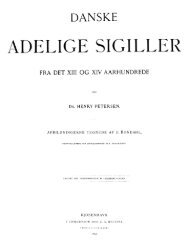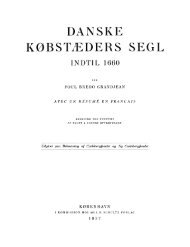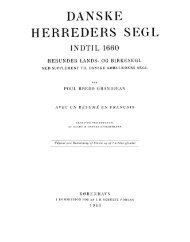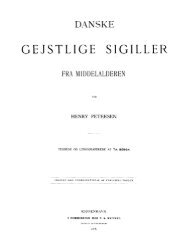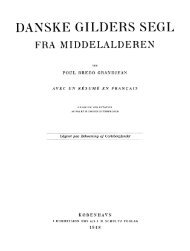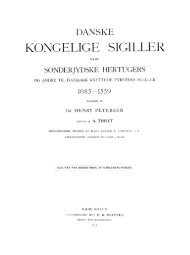Oldtidsagre - Genstandskundskab
Oldtidsagre - Genstandskundskab
Oldtidsagre - Genstandskundskab
Create successful ePaper yourself
Turn your PDF publications into a flip-book with our unique Google optimized e-Paper software.
Nr.1 157<br />
likely that the long and narrow fields in the "()ldtidsager"-groups were ploughed<br />
with an arð with a long sole, ofthe Vebbestrup-type (pictured STEENSBERG 1942, p. 10).<br />
On the other hand, it is an obvious conjecture that the long fields in certain<br />
"()ldtidsager"-groups in Jutland might be due to cultural inlluences from fertile<br />
regions where the mould-board plough and the strip-field were at that time already<br />
introduced. It may be that the arð was retaincd in poor, sandy regions, although<br />
the form of the strip-field was imitated, to some extent.<br />
Vl. Different types of ancient fields.<br />
Had the soil any influence upon the form of the fields?<br />
Two types of “()ldtidsagre" may be distinguished in Jutland: 1. A short and<br />
broad form. 2. A long and narrow form.<br />
The first of these is common. The fields are often more or less rectangular.<br />
However. they may also have more than four sides, and the angles may deviate<br />
considerably from 90°; sometimes one of the corners may be turned inwards. \\'hen<br />
three balks meet, two of the angles are often considerably more than 90 °, and the<br />
third angle considerably less than 180 °. The formation of irregular shapes is furthered<br />
by the unevenness of the terrain; however, irregular forms may also occur on perfectly<br />
flat ground.<br />
The second type does not occur so frequently, although it is dominating in<br />
some localities, namely in a considerable part of No. 12, Rødland heath, in the western<br />
part of No. 35, Byrsted heath, in No. 81, Thorsted 3, No. 83, Hoyer, No. 97, Egvad.<br />
The length of these fields is several times the breadth. One of the fields in the western<br />
part of Byrsted heath was 330 m long, and only 15 m broad.<br />
The broad fields were ploughed with arð in two directions, perpendicular to<br />
each other. That is positively known from the find of “<strong>Oldtidsagre</strong>“ with traces of<br />
ploughing beneath the village-site at Nørre Fjande (HATT 1941, pp. 157 seqq.). It<br />
seems likely, that the long and narrow fields were, in the main, only ploughed<br />
lengthwise.<br />
The broad fields were probably ploughed with an implement like the Døstruparð.<br />
The long fields may have been worked with a more effective arð, of the Vebbestrup-type.<br />
The absence of any furrows, visible on the surface, makes it unlikely<br />
that a mould-board plough was used on any of the “<strong>Oldtidsagre</strong>".<br />
The material does not permit of a sharp distinction between the short-broad<br />
and the long-narrow type of ancient fields. In the few instances where the long type<br />
is dominating, it mostly occurs together with the short and broad type. And in many<br />
localities where the short-broad type dominates, it is associated with a few fields of<br />
the long-narrow type.<br />
The division of fields in equal portions, probably at the partition of an inheri



